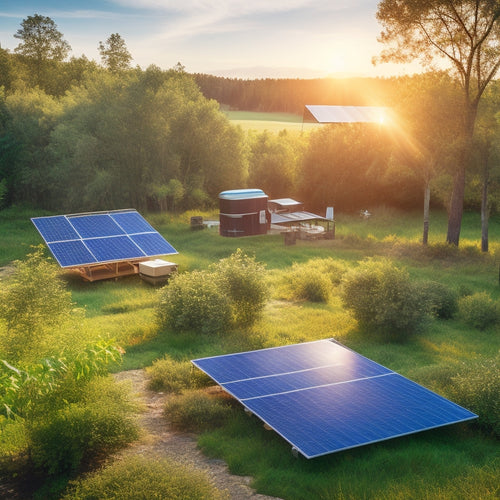
Portable Solar Power for Home Use
Share
You've turned to portable solar power for home use as a cost-effective and eco-friendly way to generate electricity, and with the right system, you can greatly reduce your reliance on traditional energy sources. By choosing the correct portable panel, you'll benefit from cost savings, minimal environmental impact, and energy independence. Consider factors like panel type, efficiency, and wattage evaluation to select the perfect fit for your needs. Properly positioning your panel, monitoring performance, and maintaining your system will guarantee maximum energy output. Now that you've taken the first step, take a closer look at the complexities of portable solar power to discover its full potential.
Key Takeaways
- Portable solar power systems can reduce your reliance on traditional energy sources, lowering your utility bills and carbon footprint.
- When choosing a portable solar panel, consider the type, efficiency, cost, and wattage to ensure it meets your energy needs and budget.
- To maximize energy output, position the panel in direct sunlight, adjust the angle throughout the day, and keep it clean and free of shading.
- Portable solar power systems can provide energy independence and emergency preparedness, making them ideal for home use during grid outages and natural disasters.
- Regular maintenance and inspections are crucial to ensure the system's performance, safety, and longevity, and to identify potential issues early.
Benefits of Portable Solar Power
You're likely considering portable solar power for home use because of its numerous benefits.
One major advantage is cost savings, as you'll reduce your reliance on traditional energy sources and lower your utility bills.
Portable solar power also has a minimal environmental impact, producing clean energy with zero emissions.
With energy independence, you'll be less affected by grid outages and rate hikes.
In emergency preparedness scenarios, portable solar power provides a reliable backup.
The lightweight design and portability advantages make it easy to use in various scenarios, such as camping or outdoor events.
Additionally, you'll have versatility options to power different appliances and devices.
Choosing the Right Portable Panel
Several factors come into play when selecting the right portable solar panel for your home use.
You'll need to evaluate the type of panel that suits your needs, with options ranging from monocrystalline, polycrystalline, and thin-film panels. Monocrystalline panels are the most efficient, but also the most expensive. Polycrystalline panels offer a good balance between efficiency and cost. Thin-film panels are the most affordable, but less efficient.
Wattage evaluations are also essential, as you'll need to determine how much power you require to charge your devices or power your appliances. A higher wattage panel will charge your devices faster, but will also be heavier and more expensive.
How to Use Portable Solar Energy
With your portable solar panel in hand, it's time to harness the power of the sun to charge your devices or power your appliances.
To get started, find a spot with direct sunlight and minimal shading. Angle your panel to maximize energy absorption. Connect your devices or appliances to the panel's output, guaranteeing compatibility and safety.
Monitor the panel's performance using the built-in display or mobile app. For peak solar energy applications, adjust the panel's position throughout the day to track the sun's movement.
As a reliable portable energy solution, your solar panel can power small appliances, charge batteries, or fuel outdoor excursions.
Always follow safety guidelines and manufacturer instructions to secure safe and efficient energy harvesting.
Portable Solar Power Systems Compared
How do portable solar power systems stack up against each other regarding performance, convenience, and cost? You'll want to evaluate the type of solar power, capacity, and features when comparing systems.
| System Feature | Monocrystalline | Polycrystalline |
|---|---|---|
| Efficiency | 20-22% | 15-18% |
| Cost | Higher | Lower |
| Portability | Compatible with portable inverter | Compatible with portable inverter |
Monocrystalline systems offer higher efficiency but come at a higher cost. Polycrystalline systems are more affordable but have lower efficiency. Both types are compatible with portable inverters, making them suitable for home use. When choosing a system, assess your energy needs and budget to select the best option for you.
Tips for Maximizing Energy Output
What's the secret to getting the most energy out of your portable solar power system? It's all about energy efficiency.
You can maximize your system's energy output by optimizing panel positioning. Make certain to position your panels at an angle that allows them to receive direct sunlight for most of the day.
Clean your panels regularly to guarantee maximum energy absorption. Avoid shading your panels, as even partial shading can greatly reduce energy output.
Consider using a solar tracker to adjust your panels' angle and direction throughout the day.
Portable Solar Power Maintenance Essentials
You'll want to establish a routine to guarantee your portable solar power system operates at its best.
This starts with daily inspection checks to identify potential issues before they become major problems.
Daily Inspection Checks
Your portable solar power system is a significant investment, and daily inspection checks are essential to ensuring its ideal performance and longevity.
You should establish a routine to inspect your system daily, focusing on safety protocols to prevent electrical shock, fire hazards, or other risks.
Check the electrical connections, ensuring they're secure and not damaged. Verify that the solar panels are clean and free of debris, which can reduce energy output.
Inspect the battery and charging controller for signs of wear or malfunction.
Set a reminder to perform these checks at the same frequency, such as every morning, to maintain a consistent inspection routine.
Storage Best Practices
Proper storage of your portable solar power system is essential when not in use, as it directly impacts the system's overall performance, lifespan, and safety. When storing your system, you should keep it in a cool, dry place away from direct sunlight and moisture. This will help prevent damage to the solar panels and battery.
| Storage Condition | Battery Capacity | Charge Cycles |
|---|---|---|
| Ideal (cool, dry) | 100% | 500-1000 |
| Poor (hot, humid) | 80% | 200-300 |
| Extreme (direct sun) | 50% | 100-200 |
Frequently Asked Questions
Can I Use Portable Solar Power in Areas With Limited Sunlight?
You can still utilize solar power in areas with limited sunlight by investing in high-efficiency solar panels and optimizing their angle and placement to maximize energy output, ensuring reliable limited sunlight solutions for your needs.
Are Portable Solar Panels Compatible With All Electronic Devices?
You think you can just plug any device into a portable solar panel and voilà, instant power? Not quite. You'll need to check the panel's power output and your device's voltage requirements to verify compatibility, or you might end up with a fancy paperweight.
How Long Does It Take to Charge a Portable Solar Battery?
When charging a portable solar battery, you'll find the time it takes depends on charging factors like sunlight intensity and battery capacity; for example, a 500Wh battery might take 5-8 hours to fully charge in ideal sunlight conditions.
Can I Expand My Portable Solar Power System Later?
Flexibly forging your future, you can flawlessly expand your system's scalability, accommodating future upgrades with ease, ensuring seamless integration and safe operation, as you cleverly customize your setup to meet changing energy needs.
Are Portable Solar Panels Durable Enough for Outdoor Use?
You'll find that many portable solar panels undergo rigorous durability testing, ensuring they can withstand harsh outdoor conditions; look for products with weather resistance certifications, such as IP65 or higher, to guarantee reliable performance.
Related Posts
-

Smart Home Thermostats to Revolutionize Your Space
Smart home thermostats revolutionize your space by providing precise temperature control and optimizing energy saving...
-

Solar Powered Lights for Sustainable Home Decor
Solar-powered lights offer a stylish and eco-friendly way to enhance your home decor. They capture sunlight, converti...
-

Top Off Grid Solar Batteries for Renewable Energy
When seeking top off-grid solar batteries for renewable energy, consider options with advanced battery chemistry, suc...


